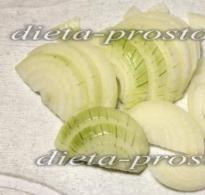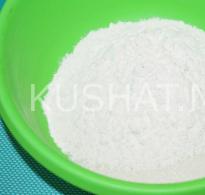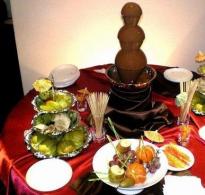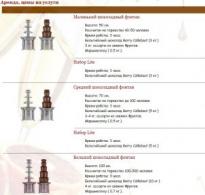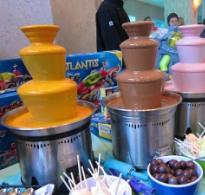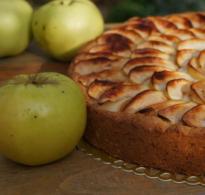How many ml of water in 1 tsp. The volume of a tablespoon, the volume of a teaspoon and about spoons in general
Very often, housewives, when preparing some culinary dish, pastry, or a decoction of herbs according to a new recipe, they ask themselves the question: how, without weights or a measuring cup, with the help of improvised objects, determine the weight, volume of a particular product.
And most often such measuring utensils become a tablespoon, a glass. The volume of the glass is usually known in advance. And not everyone knows how many milliliters or grams are included in a tablespoon.
Grams, milliliters - what's the difference?
There is no difference for water. 1 gram is equal to 1 milliliter, and 1 kg of water corresponds to 1 liter. But there is a significant difference between these concepts. In grams, weight is measured in liters or milliliters - its volume. It's all about the density of the product.
Take, for example, vegetable oil. You probably noticed that any fat, oil in finished product floats on the surface of the water. This is because it is lighter than water in weight. 1 liter of oil weighs 900-930 grams.
And one more small note. Sometimes the volume is indicated in cubic centimeters or decimeters. How to understand such information? We remind you that 1 ml corresponds to 1 cm 3, and 1 liter is a cubic decimeter.
Volume of a tablespoon for liquids
But let's get back to our tablespoon. What it is, no need to explain. This is a cutlery with which people eat liquid, loose food, such as porridge or soup.
And also the housewife's measuring tool, which she uses to salt the same soup, add sugar to compote, put butter in porridge, without thinking at all about physical categories. She just knows that half a spoon of salt is enough for this pan, and it is better to put 2 tablespoons of oil.
Let's see how many milliliters are in a tablespoon? This cutlery has its own volume. In Art. a spoon holds 18 milliliters of water. For liquid vegetable oil the volume will also be 18 ml or 16 grams by weight.
Rubbing alcohol is also lighter than water. 100 ml of alcohol weighs 78 grams. Accordingly, 18 ml strong alcohol in a cutlery are 14 g.
And condensed milk or sour cream is denser than water, due to the milk components contained in them, and, accordingly, heavier. 21-22 g of milk product will fit in 18 ml of container. Have a similar weight soy sauce, or fruit syrup.
The question of how many milliliters is in a teaspoon is usually asked by young mothers or housewives. After all, most often in cooking and medicine, to measure the weight of something, they use not weight, but volumetric measures of measurement. The most popular item used to calculate dosage accuracy is a teaspoon. Therefore, it is very important to have an idea of \u200b\u200bhow many ml fit in such a cutlery.
When it comes to medicines that need to be given to the baby, one has to involuntarily think about the accuracy of the measurement. With a small weight of crumbs, each ml can make a difference. When you use a teaspoon as a measure of volume, pay attention to where and by what standards it is produced.
In our country, a teaspoon has its own standard and is produced in accordance with GOST 24320-80. So, this cutlery known to everyone in household use holds about 5 ml of liquid. In England it is much less. The capacity of such a spoon is approximately 3.55 milliliters. In turn, the American analogue of cutlery is closer to the Russian version. A spoon holds 4.92892159 milliliters of liquid.
So the answer to the question "How many ml in a teaspoon?" is not a secret, but has a completely reasonable justification. After all, the exact figures for the capacity of the cutlery depend on the country of its release and, accordingly, the manufacturing standards.
It is worth noting that the history of the appearance of teaspoons dates back to the 18th century. It was during this period that coffee houses and tea houses began to appear. Such a spoon was originally used to measure the amount of tea leaves. They were made of steel, precious and non-ferrous metals. Spoon handles often became objects of art, emphasizing refined taste its owner.
Cooking recipes often mention the exact amount necessary ingredients, and inexperienced housewives do not always know how to measure them. To do this, you need a kitchen scale, a measuring spoon or a measuring cup, but not every kitchen has them. In extreme cases, you can use cutlery, if you know exactly how many milliliters are in a tablespoon and a teaspoon.
Volume of a tablespoon
Cutlery is familiar to any person. With their help, we eat soups, cereals, jams and jams. The spoon can be called the oldest of the devices: its history began long before the appearance of forks and knives. Previously, clay, wood, bronze, metal served as a material for its manufacture. Now this device is made from of stainless steel. The main types of the device: large, tea and dessert. Now there are more than 10 types of them: bar, for caviar, for olives, souvenir, personalized and others.
Did you know that with an ordinary spoon you can measure the mass of food?Volume of a tablespoonV different countries may differ. In the USA it is 14.95, and in the UK it is only 13.8 ml. In Russia, it is believed that its capacity is approximately 14 to 20 ml. It should be clarified that the volume and weight of the products may be different. For example, one tablespoon of sunflower oil contains 16 milliliters, and its weight will be 18 grams.
Weight in 1 tablespoon:
| Name | Number of grams |
| Honey | |
| Buckwheat | |
| Condensed milk | |
| Wheat flour | |
| tomato paste | |
| Rice | |
| Powdered milk | |
| Salt | |
| Cocoa | |
| Natural coffee | |
| Potato starch | |
| Poppy | |
| ground nut | |
| Black pepper | |
| Egg powder | |
| Gelatin |
Measuring liquids is easy. But they are different, conditionally distinguish between the following types:
- true (water, vinegar, wine);
- dense (milk, cream, syrups, liquid honey);
- thick mixtures (sour cream, condensed milk, tomato paste).
Spoons are also different types. Each person in the kitchen has several sets. They differ visually and in volume. There are several ways to find out the capacity of the spoon that you have. The easiest is to compare it to the plastic medicine container that comes with syrups. Measure the liquid first with a measuring plastic one, and then with the one you have, and compare the indicators. So you will find out the exact number of ml of the product in a tablespoon that is in your kitchen and the measurement error will be minimal.
How many ml in a tablespoon of water
For cooking on culinary sites, the exact number of milliliters of water is given. When preparing pastries (cakes, muffins), baby food you must strictly adhere to the recipe. For this you need to knowhow much water is in a tablespoon.One tablespoon of the standard sample contains 15 ml of water. Interesting fact that the weight of water is equal to its volume, i.e. 18 ml of water has a mass of 18 grams.

How many ml in a tablespoon of vinegar
In recipes, vinegar is indicated in milliliters. But measuring it is not difficult. It is a true liquid, its mass equals its volume. Approximately 15ml of vinegar in a tablespoon. Knowing its exact amount is necessary for the hostess for conservation, when preparing pastries, salads, sauces, roasting meat, fish, vegetables. It's a great dressing and preservative.
How much oil in a tablespoon
To find out how muchml of oil in a tablespoon, you need to know its type. What volume of different types of this product contains one large device:
These data are necessary for the cook to prepare salads, deep-frying, pizza, pastries and many desserts. Remember linseed oil do not expose to heat (fry on it, season hot dishes). It is best to eat it raw.
How many ml in a tablespoon of syrup
To measure sugar syrup with precision is sometimes necessary. This may be necessary in cases where a person is on a diet, considers energy value or BJU, to carefully follow the instructions for the recipe. It is much more convenient to do this not with a glass, but with one spoon. There is a special table with which you can find out that 18ml of syrup in a tablespoon weigh 22 grams.

The volume of a teaspoon and a tablespoon
When cooking, you need to knowthe volume of a teaspoon and a tablespoon.Special culinary tables indicate the quantity for bulk products with and without a slide. Measures indicated for milk, tomato paste and other ingredients that are often found in our kitchen. It is believed that 1 tsp. - 5 ml, and 1 tbsp. – 15. Having information about how many ml contains kitchen tools, and, having a culinary table, you will skillfully prepare a dish of any complexity.
Using these items to determine the weight is very convenient, but there are some nuances that affect the accuracy of measurements. This is the shape and depth of the device. It is best to measure small volumes, then the error will be minimal. For weighing large quantities, it is better to use a kitchen scale. In the manufacture of medicines, tinctures and cosmetics it is best to use graduated containers and precise measuring instruments, as any deviation from the recipe in this case can be important or even dangerous.
Video: how much liquid is in a tablespoon in ml
Cutlery has a fairly wide functional range. This is especially true of a spoon, which can not only take liquid food, but also be used as a measuring container in milliliters, when it is not a question of large volumes. We have prepared tables, how many ml. various products fits in a tablespoon, how many ml. placed in the dessert and tea rooms.

A standard tablespoon is 20 cm long, a menu spoon is 21 cm. Of course, these figures are arbitrary and may fluctuate, as they have different forms and design. Their size is even affected by the country of origin. The table below is formed from the volume indicators of a standard European-shaped menu spoon, which is now commonly used in Russia as a table spoon.
What else matters? The ingredients in milliliters indicated in the table are filled to the very edges of her “cup”. It is extremely difficult to take such a “full” spoon without spilling the contents. And in order to use the spoon as a measuring object, 1-3 ml of the given volume in the table should be removed.
It should also be taken into account that the liquids themselves can be of different densities and this also affects the number of milliliters. For example, water is a fluid consistency, vegetable oil is a dense consistency, sour cream is a thick consistency. The fluid consistency of the ingredient has an absolute value and is almost always equal to 18 ml (in the dining room). The viscous and thick consistency of the product has a different density, which means, and hence the volume in ml. may be completely different.
How many ml. in a tablespoon of products - table:
| The product's name | ml |
| How many ml of water in a tablespoon | 18 |
| Milk | 18 |
| Sour cream | 20 |
| Condensed milk | 19 |
| 20 | |
| Vegetable oil | 18 |
| Butter | 20 |
| Butter ghee | 18 |
| olive | 18 |
| Sesame | 22 |
| Linen | 18 |
| Liquid tincture | 18 |
| 19 | |
| Liquid syrup | 18 |
| Syrup thick | 19 |
| table vinegar | 18 |
| tomato paste | 21 |
How many milliliters are in a dessert spoon of products - table:
| The product's name | ml |
| How many ml of water dessert spoon | 12 |
| Milk | 12 |
| Sour cream | 13 |
| Condensed milk | 12,5 |
| Honey | 13 |
| Vegetable oil | 12 |
| Butter | 13 |
| Butter ghee | 12 |
| olive | 12 |
| Sesame | 14,5 |
| Linen | 12 |
| Liquid tincture | 12 |
| Thick tincture | 13 |
| Liquid syrup | 12 |
| Syrup thick | 13 |
| table vinegar | 12 |
| tomato paste | 14 |
How many milliliters in a teaspoon of products - table:
| The product's name | ml |
| How many ml of water in a teaspoon | 6 |
| Milk | 6 |
| Sour cream | 6,5 |
| Condensed milk | 6 |
| Honey | 6,5 |
| Vegetable oil | 6 |
| Butter | 6,5 |
| Butter ghee | 6 |
| olive | 6 |
| Sesame | 7 |
| Linen | 6 |
| Liquid tincture | 6 |
| Thick tincture | 6 |
| Liquid syrup | 6 |
| Syrup thick | 6 |
| table vinegar | 6 |
| tomato paste | 7 |
The menu spoon holds 18 ml of water, the dessert spoon holds 12 ml of water, and the teaspoon holds 6 ml. classic dining room, Russian production, holds 15 ml.
You can find out the volume of your tablespoon in milliliters with an ordinary plastic syringe. To do this, water is poured into the cup (scoop) of the product with a syringe to the brim and the indicator is measured.
How many drops are in a teaspoon?

This question often arises among those who want to quickly measure out their medicine and drink it. Based on the fact that teaspoons are different, namely: teaspoons -13 cm, large coffee -14.5, small coffee - 11.5 cm, then a spoon 13 cm long was taken as a guide.
How many drops are in a teaspoon of water? Having specially measured, we got the figure - 65. Moreover, 65 drops of water filled the spoon so completely that it is almost impossible to take it without spilling it. From this we can conclude that the following amount of liquids in drops is comfortably placed in a teaspoon:
- water - 50 drops;
- liquid tincture (water consistency) - 45 drops;
- tincture of a dense consistency (like a liquid syrup) - 25-35 drops.
Sometimes you have to measure liquid with a teaspoon, dessert spoon, or tablespoon. For example, the doctor has prescribed medicine for your child or you to take 1 teaspoon or tablespoon 3 times a day. And now you are tormented by the question: - How many ml are in a teaspoon? How many ml in a tablespoon? Because in the instructions for the medicine, the dose for one dose is clearly stated in milliliters. A loving mother, fearing to harm the child, is tormented by the question: - How many ml of syrup are in a teaspoon or a tablespoon?
How many ml in a tablespoon?
You may have the same questions while preparing various culinary recipes or observing certain diets. For example, the recipe says to add 20 ml of vinegar. How many ml of vinegar in a spoon? What spoon to measure required amount liquids? How many teaspoons does a tablespoon hold, and is there some kind of dependence here?
In all medical and kitchen books, you can read that a teaspoon contains 5 ml, a dessert - 10 ml and a tablespoon - 15 ml of liquid.
It is this volume of spoons that doctors are taught at medical institutes and, based on such knowledge, they prescribe medication. Although Wikipedia says that a standard tablespoon in the CIS countries and, in particular, Russia is 18 ml.
Now we are only talking about measuring liquid with spoons. Of particular difference between water, vinegar and sunflower oil no, when dosing these products with spoons. They are all liquid. Bulk products are another matter - they can be collected both "with a slide" and without a "slide". The result in this case can differ quite significantly, sometimes by 2 or more times.
Therefore, we will not talk about the amount of bulk products (sugar, flour, soda, salt) in one spoon today.
Today in your house there are spoons from different manufacturers, made to different standards. Therefore, the number of milliliters of liquid that are placed in them, it would seem, should differ in a fairly wide range. But it's not. All of them approximately meet the following standards:
1 teaspoon = 5ml
1 dessert spoon = 10 ml or 2 teaspoons
1 tablespoon = 15ml or 3 teaspoons
Video. How many ml in a spoon?
It should be noted that this amount of liquid is placed in all spoons from different manufacturers. But in some it is placed with difficulty and, only due to the laws of surface tension, protrudes slightly above the edges of the spoon. In principle, it is possible to lift a spoon with such filling so as not to splash water, although it is difficult, but it is generally unrealistic to give medicine, especially to a child, in this way. And if you pour a little less liquid, then this will already be a discrepancy with the recipe.

Based on this, it is possible to use spoons to measure the amount of liquid only as a last resort.
Therefore, we recommend that you measure the medicines you take using the measuring spoon that comes with liquid medicines - syrups and potions. You can also measure the amount of liquid medicine with a disposable syringe. This is the only way to keep required dose. This is especially important when taking medications for children.
For the correct dosing of liquids in the kitchen, we advise you to purchase a set of standard measuring spoons.

You can also test one spoon from your home. Using a syringe, determine the amount of ml that she puts into herself, mark it with a special mark and put it in a certain place.
This is the only way to avoid gross errors in the dosage of the substance with spoons.
As you know, accuracy is the courtesy of kings. But sooner or later there comes a moment when mere mortals have to be scrupulous to the smallest detail, or rather, to milliliters. Suppose an infant needs to be given 5 ml of syrup, and an error of even 1 ml is unacceptable. Mom can easily cope with this if she knows how many milliliters are in a teaspoon. Let's learn how to measure!
Nothing superfluous: what you really need to know about milliliters
The milliliter is a popular unit that has been used to measure liquids for over three centuries. It is found not only in cookbooks but also in drug instructions. But how to measure specified quantity products or medicinal product? The easiest way to do this is with a spoon.
- 1 dessert spoon - 10 ml (since it is twice as much as a teaspoon);
- 1 tablespoon - 15 ml (its volume is equivalent to 3 tsp);
- 1 cup - 200 ml (40 tsp).
So, if you need a strictly metered amount of a liquid substance, then you can easily measure it with standard teaspoons: 1 tsp. - 5 ml. But this will be correct if two conditions are met: the amount is indicated precisely in milliliters, the measured liquid in its consistency corresponds to ordinary water.
Read also:
- How to measure 100 grams of sugar?
Having learned how many milliliters of water are in a teaspoon, many will doubt the accuracy of such a measurement. After all, a liquid whose density does not coincide with the density of water will have a different volume. This is quite fair, so it does not hurt to know how many different liquid products accommodates this kitchen appliance.
Are you measuring liquids correctly?

Of course, you can measure a portion of the liquid with a measuring cup with divisions. But it is much easier to do this with a spoon, especially since everyone has it.
When you start measuring out medicines or foods for meals, keep in mind that the volume and weight that 1 teaspoon holds (in other words, how many milliliters and grams) can vary dramatically. Weight is directly determined by density: the higher this parameter, the heavier the substance.
Let's get down to business. The volume of different liquids in 1 tsp. such:
- water, table vinegar, medicinal syrup, wine, vodka - 5 ml (or 5 g);
- vegetable oil - 4.9 ml (4.53 g);
- olive oil - 4.93 ml (4.49 g);
- milk - 4.9 ml (5 g);
- condensed milk - 9.3 ml (12 g);
- sour cream - 4.7 ml (5 g);
- cream - 5 ml (10 g);
- jam - 6.6 ml (17 g);
- melted margarine - 4.6 ml (4 g);
- melted butter - 4.8 ml (5 g);
- mayonnaise - 5 ml (4.16 g);
- honey (thick) - 9.2 ml (12 g); liquid - 4.93 ml (6.4 g);
- fruit puree - 7 ml (17 g);
- tomato paste - 6 ml (10 g);
- liquor - 4.93 ml (5.47 g).
We have collected the most common liquid consistency products that are found in recipes. But what if you come across some exotic ingredient? How to deal with weight and volume? Read on!
How, without knowing physics, is it easy to convert milliliters to grams?

If everything is done according to the rules, then to convert milliliters to milligrams, you need to arm yourself with a calculator, pharmacy scales and a density table of substances. There is also a special formula: multiply milligrams by the density of a substance and divide the result by 1000. Are you already bored?
Then just take note of this information: a milliliter (ml) and a milligram (mg) are not the same thing! 1 ml = 1000 mg. How to put it into practice? If it is indicated that you need to take 5 ml, for example, vegetable oil, then in terms of mg it will be 5000 mg (about 1 tsp) Did you feel the difference? Try not to get confused about these measures, as confusion about units can lead to big problems.
But the difficulties of translation do not end there. If you just add zeros, then the answer will be wrong. Use this quick translation tactic for some culinary products:
- 1 ml will be equal to 1 g for water (room temperature);
- 1 ml = 1.03 g for fat milk(for low fat, use a factor of 1.035);
- 1 ml = 0.911 g for oil;
- 1 ml \u003d 0.57 g for flour (you never know - suddenly someone will indicate its amount in ml).
The average standard is: 10 ml = 9.11 g.
Of course, this method of translation is doomed to error. It is able to frighten a person who is accustomed to the ideal order, as it reaches 14-18%. If you need to measure the liquid very accurately, then take not the usual kitchen "tool" in the form of a teaspoon, but a special measuring spoon with divisions (it is sometimes attached to the medicine and is sold in the store).
Sooner or later there comes a time when the baby needs to be given some medicine. Depending on the age and weight of the child, the doctor prescribes a certain dose of the drug, and many parents face the question of how to accurately measure it? And if the child is also a newborn, then how to make him swallow it? To all these questions, we will find answers today.
Let's start with the fact that quite often doctors prescribe to give the child a teaspoon or half a teaspoon of this or that drug. How much is a teaspoon? Usually you think seriously about this when you have a small baby, which, in view of its small weight, an overdose can be fraught with. negative consequences, but teaspoons, be that as it may, are still different. In medicine, it is generally accepted that a teaspoon is 5 ml, respectively, half a teaspoon is 2.5 ml.
0.5 teaspoon = 2.5 ml
1 teaspoon = 5 ml
1 dessert spoon = 2 teaspoons = 10 ml
1 tablespoon = 3 teaspoons = 15 ml
Got it sorted out. Now the question is, how to measure this dose and give it to the baby so that he swallows it?
MEASURING SPOON
Option one - which is completed with some medicines, mainly syrups. Everything would be fine, but only the baby no, no, yes, and he will knock this spoon out of your hands or push it away so that the medicine will spill. Quite crumbs and do not yet know how to drink from a spoon. As for me, this is an option for older children and calmer.

MEASURING SYRINGE
The second option is a syringe. You buy the most ordinary syringe at the pharmacy, you can immediately put the needle aside, you don’t need it, and measure the necessary dose of medicine with it. Some antipyretic drugs are also equipped with special measuring syringes, from which it is very convenient to give any liquid medicines.
DRAW THE DRUG INTO THE SYRINGE IN ADVANCEBefore you take the baby in your arms, measure the required dose of medicine in advance. If you need to dilute the drops in water, you can do this in a spoon and draw it into a syringe.
HOLD YOUR BABY CORRECTLYIf the baby is not yet sitting, this is not a reason to drink it lying down. Hold his head in the crook of your elbow as when feeding and hold his arms so that the medicine does not dislodge.
POINT THE JET ON YOUR CHEEKSlowly squeeze out the medicine, directing the jet to the cheek, and not to the throat. Do not hurry. Let the baby swallow the medicine.
Remember the cartoon, how the boa constrictor was measured in parrots? That's in life: you open the recipe, and everything is painted there in "pinches" and ounces. Immerse yourself in the search for information. But here's the problem: the numbers are so contradictory that you get even more confused. It's time to put an end to this. Let's start small: how many ml in a teaspoon?
How many ml in a teaspoon?
A teaspoon as a unit of volume is widely used in cooking and pharmaceuticals. common abbreviation ‒ tsp By the way, the teaspoon has been used as a convenient unit of volume since the middle of the 17th century. It is approximately ⅓ of a tablespoon, 1/40 cup or 5 ml.
The unit of volume, equal to 1×10⁻³l, is an off-system metric value, fractional in relation to a liter, and is called a milliliter. Accepted abbreviation ‒ ml. A milliliter is equivalent to one cubic centimeter.
Determine the amount of liquid
For recipes liquid is usually measured in units of volume. One of the traditional tools for measuring liquid volume is a teaspoon. Initially, it was equated to ¼ tablespoon, later this measure was revised and refined to ⅓ parts. How many ml of liquid are in a teaspoon?
This is the ratio that the American dietary measurement system uses today. To be precise, one teaspoon contains 4.92892159375 milliliters. American dietetics for the volume of 1 tsp. takes 5 milliliters, the same value is considered to be a metric teaspoon. But the British have a slightly larger teaspoon: they have a value of 5.9 milliliters. In general, for a volume unit in the form of a teaspoon in culinary purposes each country uses its own standard.
In our country, the metric teaspoon has been adopted as the standard in cooking and nutrition. Thus, the volume of the liquid is:
- 1 tsp = 5 ml;
- a dessert spoon (dl) contains 2 tsp. = 10 ml;
- a tablespoon (tbsp.) is equivalent to 3 tsp. = 15 ml;
- faceted glass filled to the level of the rim - 200 ml - 16 tbsp. l. ‒ 20 d.l. = 40 tsp;
- faceted glass filled to the brim - 250 ml - 12 dl. + 1 tsp = 50 tsp
How much does a teaspoon ml of dry foods contain?

Very often, in recipes, the required amount of components is indicated in spoons, and in grams, and in milliliters, and in glasses. Of course, you can find another recipe with a more adequate description, but you need to spend some time on this, which is always not enough. In addition, it can be exclusively, from which it is impossible to deviate one iota, and it is impossible to find another such.
|
Name of products |
Tea spoon |
Tablespoon |
||||
|
Vegetable oil |
||||||
|
Butter |
||||||
|
Powdered milk |
||||||
|
Whole milk |
||||||
|
Condensed milk |
||||||
|
Breadcrumbs |
||||||
|
Semolina |
||||||
It should be noted that all the data given in the table correspond to a full teaspoon or tablespoon with a slide. In the case of a glass, we are talking about faceted dishes filled to the brim. And of course, for ease of reference, rounded values are given, calculated to the nearest tenth. By the way, to convert grams to milliliters, it is not enough just to assign a few zeros to the indicators. Everything is a little more complicated.
Since we need to move from one system of measurements of a unit of volume to another, for each product there will be an appropriate conversion factor calculated by the formula V = W / ρ, where:
- V is the volume of the substance (m³ or l);
- W is the weight of the substance (kg);
- ρ is the density of the substance (kg / m³), determined according to special tables. Each product has its own density.
The following is some interesting data compiled from the most common queries from homemakers on the Internet:
- The first place in the ranking is occupied by the following question: 5 ml is how many teaspoons? The answer is simple: 1 tsp.
- The next question is the opposite of the first: 1 teaspoon - how many ml? We answer: 1 tsp. = 5 ml.
- 10 ml is how many teaspoons? 2 tsp. or 1 d.l.
- 2.5 ml is how many teaspoons? This volume takes ½ tsp.
- 2 ml is how much in a teaspoon? This question took a little thought. But there is another unit for measuring the volume of a liquid. ‒ drops. So, 2 mg is 40 drops or 2 g, or 0.4 tsp.
How many drops in a milliliter, a teaspoon and a tablespoon.
In cooking, in the treatment of the family, in cooking home cosmetics and in dozens of household chores, the question often arises: how to measure 1 ml of liquid, how to drip 30 drops without a pipette, and much more. This is what our article is about.
How many drops are in 1 ml, one teaspoon and a tablespoon of water?
In order to know exactly how many milliliters in different small volumes, keep this table for yourself. In addition, always have a spare insulin syringe in your first aid kit. Of course, you can calculate milliliters drop by drop, but a syringe will make the job much easier.
When taking medications, you can often find the following information in the instructions: take n the number of milliliters, while no dispensers are provided.

In principle, the consistency of iodine is similar to the consistency of water, therefore, their volume will be approximately the same. It follows that one teaspoon contains approximately 100-110 drops of iodine (5 ml), and a tablespoon contains 300-310 drops of iodine (15 ml).

If you plan to use iodine in everyday life, then +/- a few drops will not play a significant role.
How many drops are in 1 ml, one teaspoon and a tablespoon of hydrogen peroxide?
Hydrogen peroxide is simply a "magic" folk remedy for cleaning the house of dirt and stains. But in most recipes, milliliters are written. We assure you right away that in folk recipes it is written exactly on paper only, but in life everything is “by eye”. But if you really want to keep the proportions - everything is simple:
5 cm of hydrogen peroxide = 100-115 drops = 1 teaspoon.

How many drops are in 1 ml, one teaspoon and a tablespoon of oil?
The consistency and viscosity of oils can be quite diverse, we will consider two types of oils: essential and base oils (they include burdock, sunflower, coconut and other common ones). Of course, these are approximate data, but in household use this accuracy will be enough.
Essential oils:
- 1 drop - 0.06 ml;
- 10 drops - 0.6 ml;
- 1 ml - 17 drops;
- 1 teaspoon = 5 ml = 83 drops;
- 1 tablespoon = 3 teaspoons = 15 ml = 250 drops.
Base oils:
- 1 drop - 0.03 ml;
- 10 drops - 0.3 ml;
- 1 ml - 33 drops;
- 1 teaspoon = 5 ml = 167 drops;
- 1 tablespoon = 3 teaspoons = 14 ml = 467 drops.
10, 15, 20, 30, 40, 50 drops - how much in a teaspoon?
We will give average values, but depending on the fluidity, or vice versa, the viscosity of the substance measured dropwise, the volume may vary.
- 1/16 to 1/18 teaspoon - 15 drops;
- 1/7 to 1/13 teaspoon - 20 drops;
- 1/4 to 1/6 teaspoon - 30 drops;
- 1/3 teaspoon - 35-40 drops;
- 1/2 teaspoon - 45-55 drops.
Of course, measuring out half or a third of a spoon will not be difficult, but here's how to measure "by eye" 1/18, to be honest, we don't know. But we know exactly how to measure such small dosages drop by drop without a pipette.

We offer you several options for solving this problem without a pipette:
- Open the first aid kit and check the medicines with pipettes or dispensers for the expiration date - perhaps something can already be released and used;
- Check if there is an insulin or a small regular syringe at hand, it often helps housewives;
- Look for a drinking straw. It is easy to use - just draw liquid, close one tip with your finger and slowly drip into the required container;
- Dip your finger, and make a miscalculation by drops flowing from it (suitable when you need to measure 1-3 drops, and it’s not a pity to transfer the rest);
- A tablespoon is full, put another spoon under it and carefully dig it, calculating the required amount.
And remember that if you are making homemade cosmetic or household blends, some inaccuracy is not terrible. But if you measure out medicines, it is best to measure out with a syringe or a special dispenser. After all, a small amount of medicine may not help, and an overdose can harm.

